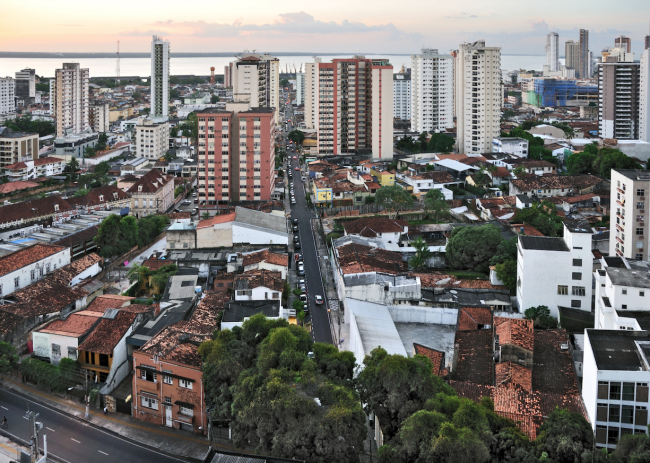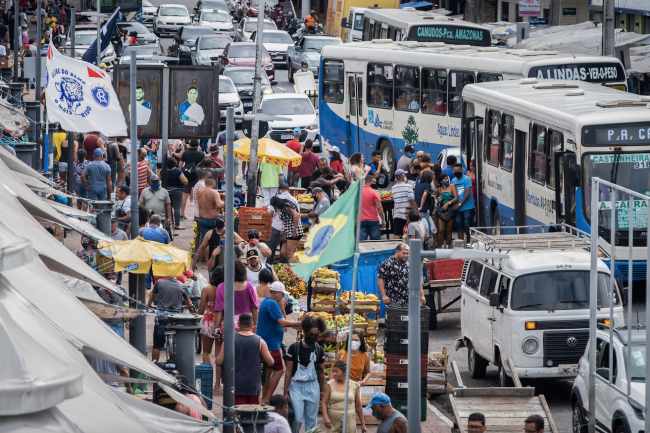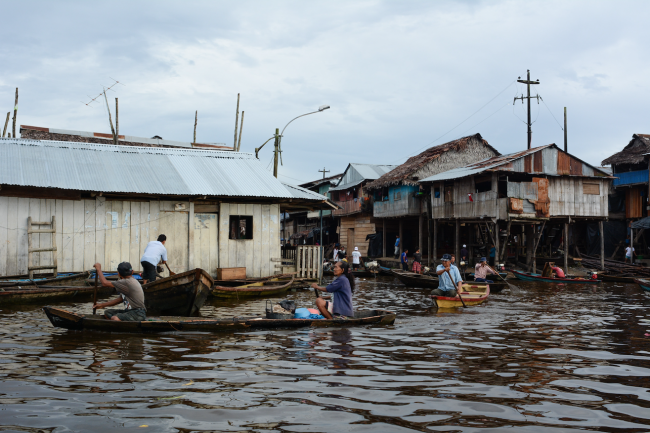
This piece appeared in the Summer 2023 issue of NACLA's quarterly print magazine, the NACLA Report. Subscribe in print today!
On my first day in Belém do Pará, the Brazilian city near where the Amazon River meets the Atlantic Ocean, I got lost. It was around noon, and I was looking for an archive for my doctoral research about Amazonian urbanization. The sun was frying me. There were not many trees or large buildings, so shade was hard to come by. I had ended up in a section of town that appeared to make little sense to Google maps and did not conform to some of my own expectations of urban life. I walked aimlessly for a while, winding irregular shapes along streets that followed the paths of meandering streams rather than the foolproof grid patterns of other parts of the city. Most of the streets were unpaved, and the heavy rain that hit almost daily turned them muddy.
As I stood on a corner wondering where to go, a refuse cart pulled by a donkey passed by at full speed, its driver vociferating the words of a song I did not recognize. Even though it would take less than 40 minutes, with heavy traffic, to get from where I was to a central area of the city, I momentarily felt lost in a remote, unfamiliar place. Adrift, I suddenly remembered that a friend had just spent time doing research in Belém, too, a few months earlier. It was a long shot, but I texted her to ask if she knew how to find the archive. She quickly offered helpful instructions. Above all, however, she reminded me where I was: in a bustling, cosmopolitan city.
My friend’s message about how she missed Belém, a city of more than 2 million people, woke up the urban scholar in me from my dehydrated and disoriented stupor. Immersed in the sensations and tropes that shape so many outsiders’ views of Amazonia, I had been missing the forest for the trees. The neighborhood was indeed lively, even chaotic, in the way only cities are. There were auto body shops, small stores, little bars and restaurants, and, of course, busy streets.
Following the recommendation of different people I had spoken to, I headed to a small restaurant, a lunch-only joint in the garage of a house. There, over fried fish, I struck up conversation with the owner, a man who must have been in his 70s. He told me that the fish I was eating could once have come from the neighborhood streams, but now they were canalized, polluted, and mostly stagnant—devoid of all life, except for the mosquitoes. The recipe for the spicy sauce I was enjoying, he explained, had come with him from the neighboring state of Piauí decades ago; eating fish this way reflected the mix of Amazonian and Northeastern traditions that make up the soul of Belém. Seeing me struggle with the heat, he said he believed the city had got much hotter as it expanded, densified, and attracted more cars. He also talked about crime, potholes, and other topics you might expect an older business owner to discuss with a curious foreigner in a popular neighborhood of a large Latin American city.

Most of the world outside of the Amazon has been at least as slow as me to come to the terms with the urbanization of the rainforest. The very notion seems counterintuitive. Yet as the Amazon region becomes increasingly central in international environmental politics in the face of planetary ecological crisis, the experiences of Amazonian peoples and the processes they are part of need to be placed at the forefront. Properly understanding Amazonia is key to helping it become part of a global environmental solution, and this will only be possible by beginning to understand human life in rainforest. Since the second half of the 20th century, most of that life takes place in cities.
How Do Forests—and Cities—Think?
A tropical rainforest nearly the size of the contiguous United States, carved by some of the most powerful rivers in the world, the Amazon is divided between nine countries. To most people in these countries, and to most of the world at large, it is still largely imagined as a frontier, a region to be colonized or protected—a tabula rasa, a wilderness. In the Western imagination, the Amazon and its peoples epitomize what Haitian anthropologist Michel-Rolph Trouillot called the “savage slot:” an ideological construct shaped by tensions between utopia and control through which the West understands itself in relation to radically different “others.” In the 21st century, the Amazon is still a place where priests go to save souls, where states flex their muscles to “civilize” locals, where explorer-scientists go to “discover” new species, where NGOs “conserve” and “develop” environments, where tourists travel to “see nature,” and where adventurous intellectuals become anthropologists.
Amazonia is now home to some 40 million people, including members of more than 300 Indigenous nations, as well as people whose origins span the entire globe. Crucially, 80 percent of these inhabitants, more than 30 million people, live in cities. Amazonian cities run the gamut: from juggernauts of more than 2 million people like Brazil’s Manaus to networks of small extractive enclave towns; from historic cities like Peru’s Moyobamba to the myriad new ones that mushroom around mining ventures. Many cities house both wealthy neighborhoods complete with financial centers that would not be out of place in affluent global cities and riverine popular settlements adapted to the rainforest’s unique environmental cycles. In recent decades, Amazonian cities have become home to some of the most popular protestant churches in the Americas. They have been at the center of massive state projects, and they host the headquarters of leading research centers, NGOs, and universities. They even export tourists to the rest of the world.
All this means that, to borrow the title of Canadian anthropologist Eduardo Kohn’s memorable book, understanding “how forests think” requires interrogating how cities think, too—and vice versa. The fragility of life in Amazonia is not just about the threat of large predators and the need to hunt one’s food, but also about highways, urban epidemics, and corrupt police offers. Street smarts in a city like Iquitos, Peru, can require figuring out not only the unusual conventions of driving a motorcycle, but also how changes in the rivers transform entire neighborhoods overnight during the high-water season. As attested by a recent collection of essays about Amazonian Indigenous visions of cities, Urban Imaginaries in Native Amazonia, edited by Fernando Santos Granero and Emmanuele Fabiano, the links between the rainforest and urban centers are indeed constitutive of how the Amazon is imagined from within. Similarly, the rainforest has always been a critical element in the drive to urbanize: the creation of permanent built environments was a way to overcome nature and impose modernity. More importantly, in practice, the historical dynamic between cities and jungle has created porous, entangled socio-spatial compacts.

Boom and Bust: Roots of Informality and Inequality
The existence of pre-colonial cities in the Amazon is the subject of complex debates among archaeologists. But there is now a consensus that humans have transformed the Amazonian environment for thousands of years and that pre-colonial permanent settlements were larger and older than was once assumed. The patterns of mobility and scattered occupation that came to characterize the region also had deep roots, but in key respects these were responses to the devastating effects of colonial penetration in the rainforest that brought epidemics, labor exploitation, and other ills. Much like in the present, civilizational tropes about pre-colonial times have prevented a full understanding of permanent human settlement and anthropogenic environments in Amazonia.
The colonial missionary villages, military fortifications, slave-raiding outposts, and river navigation nodes from which Amazonian cities eventually arose were as a rule directly linked to areas of high-density Indigenous populations, if not directly built on those very spots. The oldest of these cities, including Chachapoyas, Moyobamba, and Belém, grew relatively slowly for centuries, providing entry points to the rainforest for the Spanish and Brazilian colonial empires and the nation-states that replaced them. They served as administrative centers and, over time, as outposts for the export of Amazonian commodities. These functions intensified during the 19th-century as demand for rainforest products increased and national states sought to assert control in their often-contested Amazonian borderlands.
Although the largest Amazonian cities are not always close to the official national borders, they have been crucial sites for establishing control over large Amazonian expanses. Often, these cities maintain their status as military bases and are home to important fluvial port facilities and custom houses. Cities, then, have constituted the spaces from which states “see” the Amazon and integrate them into national frameworks and the world economy. They also have been the launch points for the exploration and eventual exploitation (which are the same word in Portuguese) of Amazonian resources and peoples. In these senses, Amazonian cities are frontiers cities.
Read the rest of this article, available open access for a limited time.
Adrián Lerner Patrón is a Philomathia Fellow in the Consortium for the Global South at the University of Cambridge. He is writing a book, titled Jungle Cities, about the urbanization of the Amazon rainforest.

